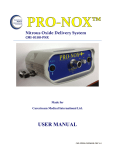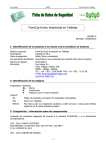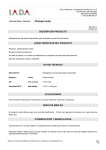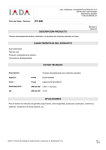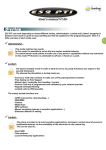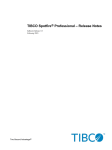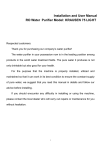Download EasyTouch ET-118 equipment cleansing kit
Transcript
Safety Data Sheet
EASY TOUCH – STREAM LCD/TFT FOAM CLEANER
Safety Data Sheet dated 8/2/2007, version 1
1. IDENTIFICATION OF THE SUBSTANCE/PREPARATION AND OF THE
COMPANY/UNDERTAKING
Trade name: PRONOX – STREAM LCD/TFT FOAM CLEANER
Trade code: ET-118
Product type and use:
Cleansing foam in Aerosols
2. COMPOSITION/INFORMATION ON INGREDIENTS
Hazardous components within the meaning of EEC directive 67/548 and corresponding
classification:
5% - 7% ethanol
N.67/548/EEC: 603-002-00-5 CAS: 64-17-5 EC: 200-578-6
F; R11
1% - 3% isopropanol
N.67/548/EEC: 603-117-00-0 CAS: 67-63-0 EC: 200-661-7
F,Xi; R11-36-67
1% - 3% butane [1]
N.67/548/EEC: 601-004-00-0 CAS: 106-97-8 EC: 203-448-7
F+; R12
1% - 3% and isobutane [2]
N.67/548/EEC: 601-004-00-0 CAS: 75-28-5 EC: 200-857-2
F+; R12
1% - 3% propane
N.67/548/EEC: 601-003-00-5 CAS: 74-98-6 EC: 200-827-9
F+; R12
0% - 1% Butylphenyl methylpropional
CAS: 80-54-6
Xn R22 R43
0% - 1% Citronellol
CAS: 106-22-9
N Xi R38 R43 R51/53
See paragraph 16 for R phrases complete text.
3. HAZARDS IDENTIFICATION
Properties / Symbols:
F+ Extremely flammable
R Phrases:
R12 Extremely flammable.
4. FIRST AID MEASURES
Contact with skin:
Immediately take off all contaminated clothing.
Areas of the body that have - or are only even suspected of having - come into contact with
the product must be rinsed immediately with plenty of running water and possibly with soap.
Contact with eyes:
Wash immediately with water for at least 10 minutes.
TEC-176/1
Page 1 of 5
Safety Data Sheet
EASY TOUCH – STREAM LCD/TFT FOAM CLEANER
Swallowing:
Do not induce vomiting. SEEK A MEDICAL EXAMINATION IMMEDIATELY and present the
safety-data sheet.
A suspension of activated charcoal in water, or liquid paraffin may be administered.
Inhalation:
Ventilate the premises. The patient is to be removed immediately from the contaminated
premises and made to rest in a well ventilated area. Should the patient feel unwell, OBTAIN
MEDICAL ATTENTION.
5. FIRE-FIGHTING MEASURES
Recommended extinguishers:
Water, CO2, Foam, Chemical powders, according to the materials involved in the fire.
Extinguishers not to be used:
None in particular.
Risks arising from combustion:
Avoid inhaling the fumes. For combustion can be form toxic gas.
Protective equipment:
Use protection for the respiratory tract.
Cool the containers exposed to the fire with water.
The aerosol containers explode if overheated and can be throwed to a great distance.
6. ACCIDENTAL RELEASE MEASURES
Measures for personal safety:
Use gloves and protective clothing.
Environmental measures:
Limit leakages with earth or sand.
Eliminate all unguarded flames and possible sources of ignition. Do not smoke.
If the product has escaped into a water course, into the drainage system, or has
contaminated the ground or vegetation, notify the competent authorities.
Cleaning methods:
Rapidly recover the product. To do so, wear a mask and protective clothing.
If the product is in a liquid form, stop it from entering the drainage system.
Recover the product for re-use if possible, or for elimination. The product might, where
appropriate, be absorbed by inert material.
After the product has been recovered, rinse the area and materials involved with water.
7. HANDLING AND STORAGE
Handling precautions:
Pressurized container. Do not pierce, do not burn, do not tamper with the valve, neither after
use.
Avoid contact and inhalation of the vapours. See, too, paragraph 8 below.
Do not eat or drink while working.
Do not smoke while working.
Storage conditions:
Always keep in a well ventilated place.
Do not expose to a temperature upper than 50 °C. Avoid direct exposure to sunlight.
Keep away from unguarded flame, sparks, and heat sources.
Store only in original and closed packages.
Do not store into passages or stairs.
Keep containers in safety position avoiding possibility of falls and crashes.
Instructions as regards storage premises:
Cool and adequately ventilated. Keep it dry.
Safety electric system.
8. EXPOSURE CONTROLS/PERSONAL PROTECTION
TEC-176/1
Page 2 of 5
Safety Data Sheet
EASY TOUCH – STREAM LCD/TFT FOAM CLEANER
Precautionary measures:
Give adequate ventilation to the premises where the product is stored and/or handled.
Respiratory protection:
Not needed for normal use.
Protection for hands:
Use protective gloves that provides comprehensive protection, solvent-resistant, e.g. PVC,
neoprene or rubber (EN 374).
Eye protection:
Use close fitting safety goggles and/or visor conforming to EN 166.
Protection for skin:
No special precaution must be adopted for normal use.
Exposure limit(s) (ACGIH):
ethanol
TLV-TWA: 1000 ppm, A4 - 1884,25 mg/m3, TLV-STEL: A4
isopropanol
TLV-TWA: 200 ppm, A4 - 491,53 mg/m3, A4 TLV-STEL: 400 ppm, A4 - 983,07
mg/m3, A4
butane [1]
TLV-TWA: 1000 ppm
and isobutane [2]
TLV-TWA: 1000 ppm
propane
TLV-TWA: 1000 ppm
ethane
TLV-TWA: 1000 ppm
9. PHYSICAL AND CHEMICAL PROPERTIES
Appearance and colour:
Odour:
pH:
Melting point:
Boiling point:
Flash point:
Autoignition temperature:
Vapour pressure:
Relative density:
Solubility in water:
Lipid solubility:
White liquid under pressure (aerosol)
Fragrance
8
< 0 °C (active matter)
< 100 °C (active matter)
< -80 °C (liquid gas)
400 °C (liquid gas)
3.2 bar at 20 °C
0,98 kg/l (active matter)
Yes
In alcohol, esters, ketones
10. STABILITY AND REACTIVITY
Stability:
The containers may explode if overheated to a temperature up to 50 °C.
Conditions to avoid:
Stable under normal conditions.
Substances to avoid:
Avoid high oxidative products and acid or basic products, which can attack the container.
Avoid contact with combustible materials. The product could catch fire.
Hazardous decomposition products:
Fumes, carbon oxides and other harmful gases.
11. TOXICOLOGICAL INFORMATION
The concentration of each substance should be borne in mind in assessing the toxicological effects
deriving from the preparation.
Set out below is the toxicological information relating to the main substances in the preparation.
ethanol
TEC-176/1
Page 3 of 5
Safety Data Sheet
EASY TOUCH – STREAM LCD/TFT FOAM CLEANER
Eyes: slight irritation
Skin: slight irritation
Inhalation: vapours may have a narcotic effect
Toxicity: effects by short or prolonged exposition not known.
isopropanol
Acute toxicity:
LD50 oral > 2000 mg/kg
LD50 skin > 2000 mg/kg
Irritation:
Skin: slighty irritant.
Eyes: irritant.
Effects on human health:
Repeated exposure may cause drowsiness and dizziness. Repeated or prolonged contact
with skin may cause skin dryness or cracking.
12. ECOLOGICAL INFORMATION
Adopt sound working practices, so that the product is not released into the environment.
13. DISPOSAL CONSIDERATIONS
Recover, if possible. Send to authorised disposal plants or for incineration under controlled
conditions. In so doing, comply with the local and national regulations currently in force.
Waste code (2001/118/EC): 16 05 04 gases in pressure containers (including halons) containing
dangerous substances
14. TRANSPORT INFORMATION
Road (ADR):
Classification code (ADR):
LQ:
UN number:
Air (ICAO/IATA):
Aerosols, flammable
Sea (IMO):
Aerosols
EmS:
Marine pollutant:
2/5F
2
UN 1950 AEROSOLS
2.1/-/2/F-D, S-U
n.a.
15. REGULATORY INFORMATION
Council Directive 67/548/EEC (Classification, packaging and labelling of dangerous substances)
and subsequent amendments. Commmission Directive 1999/45/CE (Classification, packaging and
labelling of dangerous preparation) and subsequent amendments. Commission Directive
2001/58/CE (Safety data sheets). Commission Directive 98/24/CE (Protection of the health and
safety of workers from the risk related to chemical agent). Commission Directive 2000/39/CE
(Occupational exposure limit values ).
Symbols:
F+ Extremely flammable
R Phrases:
R12 Extremely flammable.
S Phrases:
S16 Keep away from sources of ignition - No smoking.
S2 Keep out of reach of children.
S43 In case of fire, use... CO2, Foam, Chemical powders, according to the materials involved
in the fire.
S46 If swallowed, seek medical advice immediately and show this container or label.
S9 Keep container in a well-ventilated place.
TEC-176/1
Page 4 of 5
Safety Data Sheet
EASY TOUCH – STREAM LCD/TFT FOAM CLEANER
Contents (Reg. EC 648/2004): aliphatic hydrocarbons <5%, amphoteric surfactants <5%, cationic
surfactants <5%, parfum, Butylphenyl methylpropional, Citronellol.
Special Provisions:
Pressurized container. Protect from sunlight and do not expose to temperatures exceeding 50
°C. Do not pierce or burn, even after use.
Do not spray on a naked flame or any incandescent material. Keep away from sources of
ignition - No smoking. Keep out of reach of children.
Warning:
Pressurized container. Protect from sunlight and do not expose to temperatures exceeding 50
°C.
Do not pierce or burn even after use. Avoid direct inhalation and spray into the eyes.
Do not spray on naked flames or any incandescent material. Take precautionary measures
against static discharges.
Keep away from sources of ignition – No smoking. Keep out of the reach of children.
Avoid excessive or improper use that may cause possible heap of flammable gases in the air.
Operate in aired place or air immediately after use. Use the product out of flames, heat
sources, working electric devices.
Where applicable, refer to the following regulatory provisions :
Regulation (EC) No. 648/2004 ('Detergents').
Directive 2003/105/CE ('Activities linked to risks of serious accidents').
16. OTHER INFORMATION
Main bibliographic sources:
ECDIN - Environmental Chemicals Data and Information Network - Joint Research Centre,
Commission of the European Communities
SAX's DANGEROUS PROPERTIES OF INDUSTRIAL MATERIALS - Eight Edition - Van
Nostrand Reinold
ACGIH - Threshold Limit Values - 2004 edition
The information contained herein is based on our state of knowledge at the above-specified date. It
refers solely to the product indicated and constitutes no guarantee of particular quality.
It is the duty of the user to ensure that this information is appropriate and complete with respect to
the specific use intended.
This MSDS cancels and replaces any preceding release.
Paragraphs modified from the previous revision:
3. HAZARDS IDENTIFICATION
Text of R phrases referred to under heading 2:
R11 Highly flammable.
R12 Extremely flammable.
R22 Harmful if swallowed.
R38 Irritating to skin.
R43 May cause sensitization by skin contact.
R51/53 Toxic to aquatic organisms, may cause long-term adverse effects in the aquatic
environment.
TEC-176/1
Page 5 of 5





